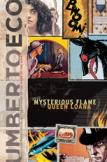In a Fog
The best-selling novelist and semiotician Umberto Eco now applies his considerable skill to the matter of identity. Along the way, readers too will ponder who we are and how we know who we are.
In The Mysterious Flame of Queen Loana: An Illustrated Novel, Eco’s protagonist, Yambo (full name: Giambattista Bodoni, after the famed 18th-century Piedmontese typographer), a 60-year-old Milanese antiquarian book dealer, embarks on a quest to rediscover himself. After an incident that causes him to lose his autobiographical memory, he must break through the fog of his amnesia. His doctor tells him, You haven’t lost your semantic memory, you’ve lost your episodic memory, which is to say the episodes of your life.
But fog, the controlling image of the novel as well as its protagonist’s obsession (before his amnesia, Yambo had collected a compendium of fog-related quotations), hinders his struggle.
Yambo’s efforts to recapture those episodes lead the reader into the fog as well, combining elements of the picaresque, the detective story, the dream vision and even the bildungsroman (despite his age, Yambo experiences each recovered event as if for the first time).
In the novel’s brief first part, the reader accompanies Yambo, in 1991, from his hospital room to the apartment he shares with his psychologist wife, Paola. His paper memory is gargantuan and accurate. So, too, says il dottore Gratarolo, are his automatisms. Consequently, while Yambo can brush his teeth and handle his car expertly, Paola must rebuild for him their 30-plus years together.
Narrated in the first person, The Mysterious Flame of Queen Loana challenges Eco, who teaches at the University of Bologna, to fashion a credible hero who, having no recall of previous relationships, is unable to interact with others. He must first recover knowledge of past actions in order to say what I’ll do next.
While the narrative form offers the reader a fully imagined protagonist, in Part One it does not work as well with the supporting characters, who behave more as caricatures than fully enfleshed persons. Nonetheless, the reader is unconvinced that Yambo’s wife, daughters and grandsons, his best friend Gianni, and his beautiful young assistant, Sibilla (Could I have had an affair with Sibilla?), can be so matter-of-fact at the loss of their respective shared pasts. All the tension runs inward and is manifest in Yambo’s own suffering as he attempts to navigate his world minus a well-worn map.
This narrative challenge is overcome in Parts Two and Three, in which the pivotal experiences of Yambo’s childhood and adolescence, which coincide with the rise of Fascism and World War II, are relived in graphic detail.
After he reacts spontaneously and emotionally to the cover of a Mickey Mouse comic book, Yambo follows Paola’s suggestion to visit his family’s country house in Solara, where the papers of his youth are locked away. There, with the longtime family housekeeper Amalia to coddle, protect and conveniently provide him with the necessary clues to the past, he systematically mines his own Augustinian caverns of memory. Eight days in the attic at Solara revive his memory of the family’s anti-Fascist stance and offer a history of Italy’s popular culture from 1931 until 1944.
Yambo seeks the feeling he calls the mysterious flame, that familiar tug in the gut that makes physical his connection with another human being. While at the country house, he finds it in a photograph of himself and his sister Ada and at the sight of his parents’ bed. But it is his reliving of a night in the foggy Gorge during the war that becomes a focal point of the novel and most clearly illuminates Yambo’s true character.
Prodded by his anarchist mentor, Gragnola, Yambo uses his superior climbing skills and, more noteworthy, his memory of the Gorge’s every ledge and precipice, to save some Cossacks from the S.S. With the assistance of others, including the priest Don Cognasso, Yambo navigates the dense fog to ensure the Cossacks escape capture, torture and certain death. His actions signal the birth of his moral consciousness.
Unlike the scenes in Part One, the scenes here, filled with palpable tension and the raw, irrevocable consequences of individual choices, completely engage the reader.
The novel’s third part is nothing less than fantastical. Yambo’s final discovery of a Shakespeare first folio unleashes a second medical event, plunging the hero into unconsciousness. Bold images of the influential people and characters of Yambo’s past parade grandly before him, like a scene from the Ziegfeld Follies. The narrative pace quickens, and by the final page Yambo, at the brink of clarity, feels ready to explodeor blossom.
Early in the novel, Paola reminds her husband: We live in the three moments of expectation, attention, and memory, and none of them can exist without the others. You can’t stretch toward the future because you’ve lost your past.
But recover his past Yambo does, not as an accumulation of cold statistics, but rather in flashes of recognition. His relationships with those who surround him in the novel’s final pagesfamily members, comic book heroes, beauties, villains, saintsrekindle his self-identity. They constitute the record of his life. By the novel’s end, he is filled with expectation, reaching through the fog to meet them once more.
The Mysterious Flame of Queen Loana is an attractive tome, with a 19-page source list of citations and illustrations. The trademark Eco wordplay aboundsCopacabana or Capocabana? The writing entices the reader, not only with its suspenseful narrative (deftly translated by Geoffrey Brock), but also with its juxtaposition of the erudite and the popular, the personal and the global. It delights, surprises and provokes. Overall, it is a lively ride down memory lanefog lights required.
This article also appeared in print, under the headline “In a Fog,” in the August 29, 2005, issue.








